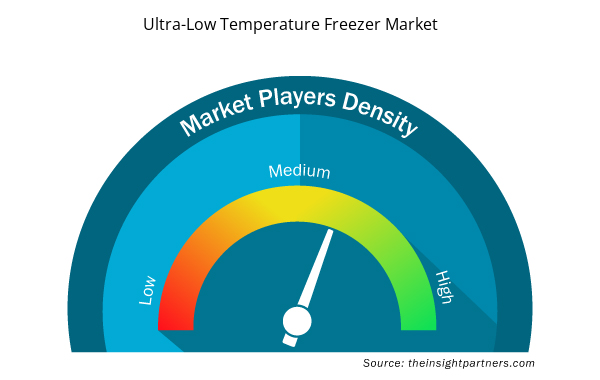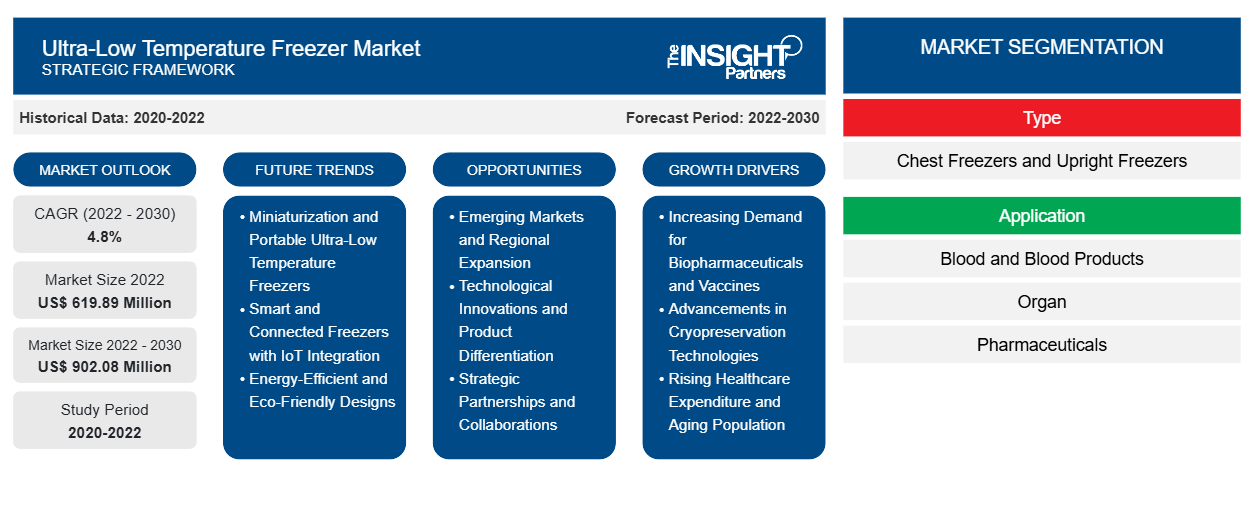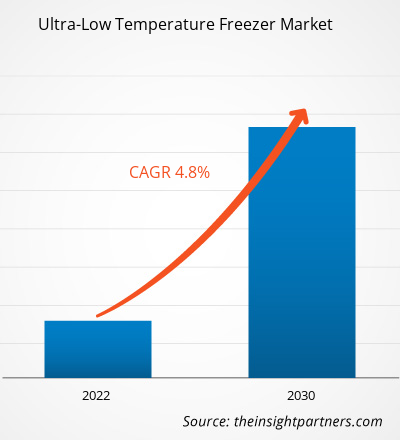[研究报告] 超低温冷冻机市场预计将从 2022 年的 6.1989 亿美元增长到 2030 年的 9.0208 亿美元;预计 2022 年至 2030 年的复合年增长率为 4.8%。
市场洞察和分析师观点:
随着研发活动不断增加以引入新药物化合物、血液和血液成分需求不断增长以及政府对研究活动和临床试验的支持不断增加,超低温冰箱市场规模正在扩大。此外,市场参与者提供的先进产品推动了市场增长。Thermo Scientific Revco RLE –86°C 立式冰箱有五种容量可供选择,可存储 300 至 700 个 2 英寸盒子。这些冰箱具有出色的热性能、安全性和保障性。
增长动力和挑战:
生物研究标本需要在低于 –80°C 的温度下储存,即超低温 (ULT) 值。ULT 功能为基于压缩机的标准冷却技术提供了一种替代方案,随着人们对它的了解不断加深,该技术也不断改进。海尔生物医疗提供的创新产品包括智能变频技术 ULT 冷冻机,其单位容量为 829 L/29.2 ft3,能耗数字无与伦比,仅为 8.2 Kwhr/天。2022 年 10 月,赛默飞世尔科技为其超低温 (ULT) 绿色产品组合推出了一款新型冷冻机,即赛默飞世尔科技 TDE 系列 -80°C 立式冷冻机。该冷冻机由 H-drive 碳氢化合物系统提供动力,可在不影响可持续发展目标的情况下提高重要研究所需的性能。 2023 年 6 月,BioLife Solutions 的斯特林超冷立式 ULT 冷冻机 ISO 6 级根据相关良好生产规范 (GMP) 获得批准,可用于洁净室应用,同时不会影响生物储存性能或环境清洁度。
ULT 样本储存冰箱是全球许多生物库、诊所和实验室的重要组成部分。这些设备可储存各种生物样本,包括 DNA、RNA、蛋白质和细胞提取物。需要恒定的电源来维持低温水平。国际可持续实验室研究所表示,普通 ULT 冰箱每天消耗的能量与单户住宅相同,为 20 千瓦时。考虑到实验室和研究机构通常同时运行数十台这样的设备,运行和能源成本可能决定用户的偏好。运行直立式机械 ULT 冰箱的平均价格每年从 750 美元(570 英镑)到 1,000 美元(750 英镑)不等,具体取决于尺寸和温度范围等几个因素。定期维护和除霜维护可以大大降低这一成本。此外,上述关于 ULT 冰箱的数据未考虑 HVAC 系统和暖风去除的额外成本。因此,超低温冰箱的高成本成为注重预算的实验室和存储设施的严重担忧。
定制此报告以满足您的需求
您可以免费定制任何报告,包括本报告的部分内容、国家级分析、Excel 数据包,以及为初创企业和大学提供优惠和折扣
- 获取此报告的关键市场趋势。这个免费样品将包括数据分析,从市场趋势到估计和预测。
报告细分和范围:
超低温冰箱市场根据类型、应用、技术和地域进行细分。超低温冰箱市场根据类型、应用、技术和地域进行细分。超低温冰箱市场根据应用分为血液和血液制品、器官、药品、法医和基因组研究等。根据技术,市场分为自动和半自动。
根据地域划分,超低温冷冻机市场分为北美(美国、加拿大和墨西哥)、欧洲(英国、德国、法国、意大利、西班牙、俄罗斯和欧洲其他地区)、亚太地区(中国、日本、印度、韩国、澳大利亚、东南亚和亚太其他地区)、中东和非洲(阿联酋、沙特阿拉伯、南非和中东和非洲其他地区)以及南美洲和中美洲(巴西、阿根廷和南美洲和中美洲其他地区)。
节段分析:
超低温冷冻机市场按类型分为卧式冷冻机和立式冷冻机。2022 年,立式冷冻机细分市场占有较大的市场份额,预计同一细分市场在 2022-2030 年期间的复合年增长率将更高。立式冷冻机细分市场的预计市场增长归因于紧凑的设计、易于组织和各种安全功能等优势。此外,由于技术进步而导致的采用率提高,从而可以更好地监督操作和简化操作,这将在预测期内增强立式超低温冷冻机市场的增长。
区域分析:
根据地理位置,超低温冷冻机市场分为北美、欧洲、亚太地区、中东和非洲以及南美和中美洲。北美是全球超低温冷冻机市场增长的最大贡献者。预计亚太地区在 2022-2030 年期间的超低温冷冻机市场复合年增长率最高。美国超低温冷冻机市场的增长主要受到肺癌患病率上升、产品发布和政府举措的推动。对生物库的需求不断增长,为美国的医疗保健和经济体系带来了变革潜力。然而,美国快速发展的生物库的直接关注点在于对疾病理解、药物发现和开发的需求。此外,生物库研究为人类疾病的遗传成分提供了新的见解,重点是开发一种自动化和更个性化的医疗保健方法。此外,美国的一些市场参与者专注于提供多样化、尖端的生物库产品和服务组合,旨在加速拯救生命的发现。市场参与者之间的商业活动不断增加,为市场增长做出了巨大贡献。2020 年 11 月,美国各州和城市的医院无视美国疾病控制与预防中心 (CDC) 的建议,难以购买辉瑞公司生产的可以安全储存 PFE.N COVID-19 疫苗的超低温冰箱。
超低温冷冻机市场区域洞察
Insight Partners 的分析师已详尽解释了预测期内影响超低温冷冻机市场的区域趋势和因素。本节还讨论了北美、欧洲、亚太地区、中东和非洲以及南美和中美洲的超低温冷冻机市场细分和地理位置。

- 获取超低温冷冻机市场的区域具体数据
超低温冷冻机市场报告范围
| 报告属性 | 细节 |
|---|---|
| 2022 年市场规模 | 6.1989亿美元 |
| 2030 年的市场规模 | 9.0208亿美元 |
| 全球复合年增长率(2022 - 2030 年) | 4.8% |
| 史料 | 2020-2022 |
| 预测期 | 2022-2030 |
| 涵盖的领域 | 按类型
|
| 覆盖地区和国家 | 北美
|
| 市场领导者和主要公司简介 |
|
市场参与者密度:了解其对商业动态的影响
超低温冷冻机市场正在快速增长,这得益于终端用户需求的不断增长,这些需求源于消费者偏好的不断变化、技术进步以及对产品优势的认识不断提高等因素。随着需求的增加,企业正在扩大其产品范围,进行创新以满足消费者的需求,并利用新兴趋势,从而进一步推动市场增长。
市场参与者密度是指在特定市场或行业内运营的企业或公司的分布情况。它表明在给定市场空间中,相对于其规模或总市场价值,有多少竞争对手(市场参与者)存在。
在超低温冷冻机市场运营的主要公司有:
- 赛默飞世尔科技公司
- 戈德瑞集团
- 海尔集团公司
- 蓝星有限公司
- 赫尔默科学公司
免责声明:上面列出的公司没有按照任何特定顺序排列。

- 了解超低温冷冻机市场主要参与者概况
行业发展和未来机遇:
以下列出了超低温冷冻机市场主要参与者采取的各种举措:
- 2023年5月,北美PHC公司(PHCNA)宣布,PHCbi品牌VIP ECO SMART超低温冷冻机荣获国际生物和环境储存库协会(ISBER)颁发的2023年杰出新产品奖。该产品设计用于大学、医疗机构和制药公司等一系列设施。
- 2023年2月,北美PHC公司(PHCNA)推出PHCbi品牌VIP ECO SMART超低温冰箱系列。该系列新冰箱以创新可靠的超低温冰箱为基础,在提高安全性和可用性的同时,提供增强的节能性能。
竞争格局和重点公司:
Thermo Fisher Scientific Inc、Godrej Group、海尔集团、Blue Star Limited、Helmer Scientific Inc、PHC Holdings、BioLife Solutions Inc、Eppendorf SE、Meling Biomedical 和 Arctiko 是超低温冰箱市场的知名企业。这些公司专注于新产品的推出和地域扩张,以满足全球日益增长的消费者需求,并增加其专业产品组合的范围。他们的全球业务使他们能够服务于庞大的客户群,从而促进市场扩张。
- 历史分析(2 年)、基准年、预测(7 年)及复合年增长率
- PEST 和 SWOT 分析
- 市场规模价值/数量 - 全球、区域、国家
- 行业和竞争格局
- Excel 数据集



Report Coverage
Revenue forecast, Company Analysis, Industry landscape, Growth factors, and Trends

Segment Covered
This text is related
to segments covered.

Regional Scope
North America, Europe, Asia Pacific, Middle East & Africa, South & Central America

Country Scope
This text is related
to country scope.
常见问题
The increasing demand for blood and blood components, and technological advancements in ultra-low temperature freezer bolster the ultra-low temperature freezer market size. However, the high cost associated with ultra-low temperature freezer hinders the ultra-low temperature freezer market growth.
Based on geography, the ultra-low temperature freezer market is segmented into North America (the US, Canada, and Mexico), Europe (the UK, Germany, France, Italy, Spain, and the Rest of Europe), Asia Pacific (China, Japan, India, South Korea, Australia, and the Rest of Asia Pacific), the Middle East & Africa (the UAE, Saudi Arabia, South Africa, and Rest of the Middle East & Africa), and South & Central America (Brazil, Argentina, and the Rest of South & Central America). North America is the largest contributor to the growth of the global ultra-low temperature freezer market. Asia Pacific is expected to register the highest CAGR in the ultra-low temperature freezer market during 2022–2030.
The ultra-low temperature freezer market is divided on the basis of type, application, and technology. The ultra-low temperature freezer market, by type, is bifurcated into chest freezers and upright freezers. In 2022, the upright segment held a larger market share. Further, the upright segment is expected to record a faster CAGR during 2022–2030.
The ultra-low temperature freezer market, by application, is segmented into blood & blood products, organs, pharmaceuticals, forensic & genomic research, and others. In 2022, the blood & blood products segment held a largest market share. Further, the pharmaceuticals segment is expected to record a fastest CAGR during 2022–2030.
The market, by technology, is bifurcated into automatic and semi-automatic. In 2022, the automatic segment held a larger market share. Further, the automatic segment is expected to record a faster CAGR during 2022–2030.
Ultra-Low temperature freezers are designed to store biological materials such as viruses, bacteria, eukaryotic cells, blood, and semen. These freezers are used in blood banks, hospitals, epidemic prevention services, research institutes, and biomedical engineering facilities. These are available in different specifications to suit specific commercial needs. For instance, the plasma once is used for storage of blood and plasma products at -30°C to 40°C, and the ultra-low temperature freezers are used for long term storage of DNA and RNA samples products at a range of 70°C to 80 °C.
The ultra-low temperature freezer market majorly consists of the players such Thermo Fisher Scientific Inc, Godrej Group, Haier Group Corporation, Blue Star Limited, Helmer Scientific Inc, PHC Holdings, BioLife Solutions Inc, Eppendorf SE, Meling Biomedical, and Arctiko among others.
Trends and growth analysis reports related to Life Sciences : READ MORE..
The List of Companies - Ultra-Low Temperature Freezer Market
- Thermo Fisher Scientific Inc
- Godrej Group
- Haier Group Corporation
- Blue Star Limited
- Helmer Scientific Inc
- PHC Holdings
- BioLife Solutions Inc
- Eppendorf SE
- Meling Biomedical
- Arctiko
The Insight Partners performs research in 4 major stages: Data Collection & Secondary Research, Primary Research, Data Analysis and Data Triangulation & Final Review.
- Data Collection and Secondary Research:
As a market research and consulting firm operating from a decade, we have published and advised several client across the globe. First step for any study will start with an assessment of currently available data and insights from existing reports. Further, historical and current market information is collected from Investor Presentations, Annual Reports, SEC Filings, etc., and other information related to company’s performance and market positioning are gathered from Paid Databases (Factiva, Hoovers, and Reuters) and various other publications available in public domain.
Several associations trade associates, technical forums, institutes, societies and organization are accessed to gain technical as well as market related insights through their publications such as research papers, blogs and press releases related to the studies are referred to get cues about the market. Further, white papers, journals, magazines, and other news articles published in last 3 years are scrutinized and analyzed to understand the current market trends.
- Primary Research:
The primarily interview analysis comprise of data obtained from industry participants interview and answers to survey questions gathered by in-house primary team.
For primary research, interviews are conducted with industry experts/CEOs/Marketing Managers/VPs/Subject Matter Experts from both demand and supply side to get a 360-degree view of the market. The primary team conducts several interviews based on the complexity of the markets to understand the various market trends and dynamics which makes research more credible and precise.
A typical research interview fulfils the following functions:
- Provides first-hand information on the market size, market trends, growth trends, competitive landscape, and outlook
- Validates and strengthens in-house secondary research findings
- Develops the analysis team’s expertise and market understanding
Primary research involves email interactions and telephone interviews for each market, category, segment, and sub-segment across geographies. The participants who typically take part in such a process include, but are not limited to:
- Industry participants: VPs, business development managers, market intelligence managers and national sales managers
- Outside experts: Valuation experts, research analysts and key opinion leaders specializing in the electronics and semiconductor industry.
Below is the breakup of our primary respondents by company, designation, and region:

Once we receive the confirmation from primary research sources or primary respondents, we finalize the base year market estimation and forecast the data as per the macroeconomic and microeconomic factors assessed during data collection.
- Data Analysis:
Once data is validated through both secondary as well as primary respondents, we finalize the market estimations by hypothesis formulation and factor analysis at regional and country level.
- Macro-Economic Factor Analysis:
We analyse macroeconomic indicators such the gross domestic product (GDP), increase in the demand for goods and services across industries, technological advancement, regional economic growth, governmental policies, the influence of COVID-19, PEST analysis, and other aspects. This analysis aids in setting benchmarks for various nations/regions and approximating market splits. Additionally, the general trend of the aforementioned components aid in determining the market's development possibilities.
- Country Level Data:
Various factors that are especially aligned to the country are taken into account to determine the market size for a certain area and country, including the presence of vendors, such as headquarters and offices, the country's GDP, demand patterns, and industry growth. To comprehend the market dynamics for the nation, a number of growth variables, inhibitors, application areas, and current market trends are researched. The aforementioned elements aid in determining the country's overall market's growth potential.
- Company Profile:
The “Table of Contents” is formulated by listing and analyzing more than 25 - 30 companies operating in the market ecosystem across geographies. However, we profile only 10 companies as a standard practice in our syndicate reports. These 10 companies comprise leading, emerging, and regional players. Nonetheless, our analysis is not restricted to the 10 listed companies, we also analyze other companies present in the market to develop a holistic view and understand the prevailing trends. The “Company Profiles” section in the report covers key facts, business description, products & services, financial information, SWOT analysis, and key developments. The financial information presented is extracted from the annual reports and official documents of the publicly listed companies. Upon collecting the information for the sections of respective companies, we verify them via various primary sources and then compile the data in respective company profiles. The company level information helps us in deriving the base number as well as in forecasting the market size.
- Developing Base Number:
Aggregation of sales statistics (2020-2022) and macro-economic factor, and other secondary and primary research insights are utilized to arrive at base number and related market shares for 2022. The data gaps are identified in this step and relevant market data is analyzed, collected from paid primary interviews or databases. On finalizing the base year market size, forecasts are developed on the basis of macro-economic, industry and market growth factors and company level analysis.
- Data Triangulation and Final Review:
The market findings and base year market size calculations are validated from supply as well as demand side. Demand side validations are based on macro-economic factor analysis and benchmarks for respective regions and countries. In case of supply side validations, revenues of major companies are estimated (in case not available) based on industry benchmark, approximate number of employees, product portfolio, and primary interviews revenues are gathered. Further revenue from target product/service segment is assessed to avoid overshooting of market statistics. In case of heavy deviations between supply and demand side values, all thes steps are repeated to achieve synchronization.
We follow an iterative model, wherein we share our research findings with Subject Matter Experts (SME’s) and Key Opinion Leaders (KOLs) until consensus view of the market is not formulated – this model negates any drastic deviation in the opinions of experts. Only validated and universally acceptable research findings are quoted in our reports.
We have important check points that we use to validate our research findings – which we call – data triangulation, where we validate the information, we generate from secondary sources with primary interviews and then we re-validate with our internal data bases and Subject matter experts. This comprehensive model enables us to deliver high quality, reliable data in shortest possible time.


 获取此报告的免费样本
获取此报告的免费样本